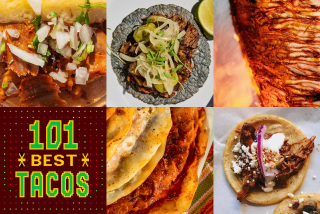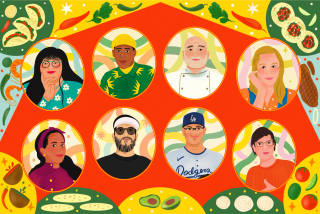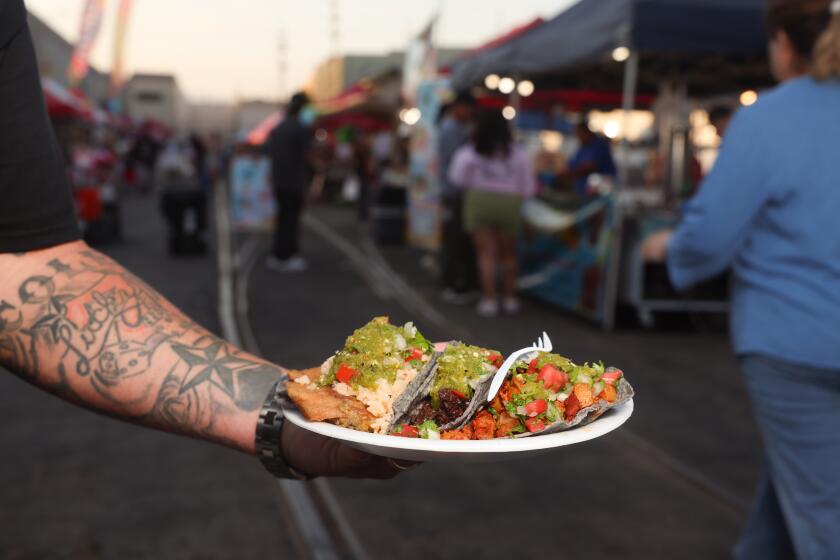The Hearty Tastes of Winter : Agriculture: Although more foods are available year-round, our appetites are still attuned to seasonal shifts.
Each new year, frigid arctic winds threaten to reduce our food supplies to chilly memories. In fact, before the advent of economical transportation and refrigeration, we were completely bound to seasonal shifts in agriculture based on temperature. The winter season brought only hearty, mature foods that could survive the cold and even some that needed the frost to finish their development.
Now, in the comfort of our heated markets, this seasonal shift merely reduces selection and quality while increasing our food bills. Our instinctual cravings have been slower to adapt to these supermarket non-seasons. During cold weather, only the robust flavors of winter can satisfy our cravings.
The winter poultry selection abounds with mature large roasting birds that are robust enough to stand the chill. Roasters range from 3 1/2 to 6 1/2 pounds with an age of 14 weeks to eight months. Their flesh is firmer and fully flavored, perfect for high-heat roasting to seal in all the juices.
The evergreen herb rosemary and other woody herb perennials provide the seasonings to match the poultry. Through summer and early autumn, we feast on tender annuals and perennials. Winter herbs, though, are coarse and strong. You can tame them by frying or sauteing in olive oil, which will extract much of the flavor into the oil and crisp their texture. The herbs become crunchy accompaniments for the roasted bird, and the oil can be used in dressings or enrich the puree of roots in the recipe that follows. Winter was never a time to waste anything.
The root vegetable family is quite under-appreciated in these modern times. Once they held the balance of life. Those that had them lived; those without perished. Stored in root cellars, these vegetables ensured our nutrition until spring.
The cold is just as important to the flavor of roots as the sun’s warmth is to sweetness in the citrus family. Most starchy roots respond to cold temperatures with a change in metabolic rates, which begins the conversion of starches to sugar. These sugars enhance the full flavors of the vegetables by covering some of the sharper compounds.
Potatoes and sweet potatoes are native to the Americas; other common root vegetables are of Eurasian origin. The potato is the most nutritionally significant of the roots. It is really a swollen tuber or underground stem and provides more edible food matter than the world harvest of fish and meat.
The potato family falls into two distinct groups: those that have a mealy cell structure that easily separates--perfect for baking or mashing--and those with a more cohesive waxy cell structure, better for maintaining cut shapes after cooking. For best boiling results, start potatoes in cold water and bring to a boil, cooking until they reach at least 140 to 150 degrees (the gelatinization range) for the cells to soften properly for mashing.
The potato is not fattening on its own--without added butter and sour cream or the fat it is fried in. Try substituting olive oil, herbs and seasonings to enrich the texture and flavor instead of butter or sour cream. Potatoes contain half the daily adult Vitamin C requirement, high-quality protein and minerals. The comfort food of mashed potatoes provides more than psychological satisfaction.
Sweet potatoes belong to the morning glory family. In the United States, the common supermarket “yam” is a variety of sweet potato, not a true yam. Sweet potatoes are higher in all nutritional values than the white potato except for protein.
Parsnips were the major root food in Europe prior to the introduction of the potato. The parsnip is harder to grow but its more pronounced flavor is truly wonderful. Its cousin, the carrot, is higher in carotene (Vitamin A), but contains less starch for purees.
The edible “root” of the turnip or the beet is actually a swollen hypocotyl (lower stem and root). Turnips were also an important pre-potato food crop. Their strong taste results from a mustard oil formed primarily under the skin, so always peel before cooking to minimize this flavor. Beets are best when roasted to concentrate their flavor and sugars; boiling tends to dilute this subtle nuance.
Celeriac or celery root belongs to the carrot family and is the starch-storing, not the greens-producing, member of the celery species. Celeriac has the least nutritional value of the roots but a wonderful nutty flavor. This rough root is easiest to handle when trimmed after boiling, then mashed or pureed. Select late-harvest roots that are firm, crisp and heavy. Roots become mushy and light when stored at room temperatures. Store in cool, dark, well-ventilated areas.
Mashed potatoes trigger a pretty basic mental picture but the combination of various root vegetables in this form unveils a spectrum of taste sensations. Potato, celery root and parsnips with rosemary-scented olive oil and black pepper will quickly erase the basic image.
ROAST CHICKEN
WITH ROSEMARY
1 cup plus 2 tablespoons olive oil
1 bunch fresh rosemary
1 roasting chicken, about 5 pounds, rinsed well
Salt
Freshly ground pepper
2 large heads garlic
Mashed Celeriac, Parsnips and Potatoes
Heat 1 cup olive oil to 300 to 325 degrees in medium skillet. Add rosemary sprigs and cook until crisp, about 2 minutes or until oil stops bubbling around rosemary. Drain rosemary on paper towels.
Remove leaves from stems, reserving 4 full sprigs for garnish. Allow oil to cool and reserve for Mashed Celeriac, Parsnips and Potatoes.
Place chicken in oven-proof skillet. Season skin to taste with salt and pepper. Rub 1/4 cup rosemary oil over skin.
Rub heads of garlic with remaining 2 tablespoons plain olive oil and add to skillet. Bake on lower rack at 400 degrees about 30 minutes or until garlic is tender. Remove garlic and keep warm while continuing to cook chicken until done, about 40 minutes longer, depending on exact weight of bird, or until instant meat thermometer inserted in thigh reads 160 degrees and juices run clear. Remove from oven.
Pour cooking fat and juices into glass measuring cup and retrieve “jus.” (If juices are caramelized, add 1/2 cup stock or wine to reconstitute.)
Carve chicken and divide among warm serving plates. Spoon juices over chicken and top with rosemary leaves. Cut each garlic heads in half across cloves and position next to chicken. Divide Mashed Celeriac, Parsnips and Potatoes among plates. Garnish each with sprig of crisped rosemary and serve. Makes 4 servings.
Mashed Celeriac,
Parsnips and
Potatoes
1 pound large parsnips
1 large celeriac, washed and trimmed
2 large boiling potatoes
1/2 cup rosemary oil, extra virgin olive oil or butter
Salt
Freshly ground white pepper
Place parsnips, celeriac and potatoes in large pan and cover with cold water. Bring to boil, cooking each vegetable until tender, about 30 minutes for parsnips and 50 minutes for celeriac and potatoes. Drain and peel vegetables and cut in large chunks.
Process vegetables in food processor, pureeing just until smooth while gradually adding rosemary oil. Season to taste with salt and white pepper. Transfer to bowl, cover and keep warm in 200-degree oven until ready to serve. Makes 4 servings.
More to Read
Eat your way across L.A.
Get our weekly Tasting Notes newsletter for reviews, news and more.
You may occasionally receive promotional content from the Los Angeles Times.






